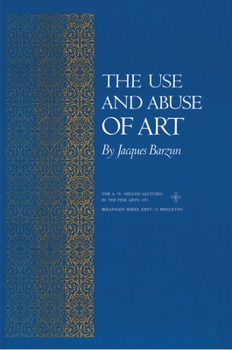The Use and Abuse of Art
(Part of the The A. W. Mellon Lectures in the Fine Arts Series)
Select Format
Select Condition 
Book Overview
From the celebrated cultural historian and bestselling author, a provocative history of the evolution of our ideas about art since the early nineteenth century
Format:Paperback
Language:English
ISBN:0691018049
ISBN13:9780691018041
Release Date:June 1975
Publisher:Princeton University Press
Length:160 Pages
Weight:0.25 lbs.
Dimensions:0.4" x 6.1" x 9.0"
Customer Reviews
2 ratings
Some good ideas
Published by Thriftbooks.com User , 14 years ago
This series of transcribed lectures can be a bit too arcane. But many of the ideas are good if you can stick with it. I put it on my night stand and read it when I was in the mood for some occasionally heavy art philosophy. Gives some good insights into the traditional/post-modern dichotomy.
How much Art to do we need?
Published by Thriftbooks.com User , 20 years ago
This is the text of set of talks in the series of A W Mellon memorial lectures at the National Gallery of Art in Washington D. C. This is number 22 in the series, delivered in 1973. Barzun comes as a lover of art, and a lover of progressive, avant garde art moreover, on the evidence of his earlier book The Energies of Art. However he sees a need to challenge art, or Art, on account of the diverse and contradictory theories and interests that are promoted under the banner of Art.To clarify his concerns he identified "three productive moments in western civilization, all of which unfortunately are called modern." First the Renaissance, representing a break from the Middle Ages from 1400 to 1600. Second, the era from the French Revolution which he labels the Romantic Period from 1789 to 1840. And finally the more recent turn of modernism in ideas, art and manners that he places at the turn of the century from 1890 to 1914.In the first lecture Barzun examined the complex of institutions and vested interests called Art to consider the contribution that they made to individual people and to society in the large. He justified this examination for two reasons: first, the power and influence that Art can exert as a vehicle of communication and second, the amazingly perverse messages that are being conveyed by Art at the present time "in opposition to every traditional idea, feeling and activity, including art itself" (24).In the second lecture he examined the rise of art as a substitute for religion in the nineteenth century. Art simultaneously became the "ultimate critic of life and the moral censor of society". The next phase in that development is the topic of the third lecture on Art the Destroyer, treating Estheticism and Abolitionism during the period 1890 to 1914. He made a rash claim that the world since 1920 "has merely amplified and multiplied what the nineties and early 1920s first achieved...a long list of inventions and activities, from flying machines and motion pictures to skyscrapers, psychoanalysis, and organ transplants, and from the concentration camp to the strip-tease, date not from now but from then. I shall suggest later on why western civilization has not had a new idea in fifty years".Atomic power and the rise of the computer would appear to test that proposition! But still, getting back to Art, he sketched its destructive function over the last 150 years (now 180). "By the tradition of the New, art unremittingly destroys past art, though by the cognate tradition of historical sympathy we deny ourselves the unity of a contemporary style. By making extreme moral and esthetic demands in the harsh way of shock and insult, art unsettles the self and destroys confidence and spontaneity in individual conduct."Art in this function has helped to undermine the assumptions that the state and civilized society are valuable or admirable, thus impairing the effectiveness of political and social institutions and proving the destroyers' own





